The Checker Maven
The World's Most Widely Read Checkers and Draughts Publication
Bob Newell, Editor-in-Chief
Published each Saturday morning in Honolulu, Hawai`i
Contests in Progress:
Uncle Ben's Porch: Moving On Up?
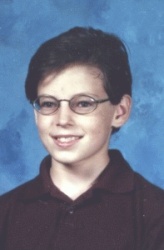
Tommy Wagner
Recall from our last story that Tommy Wagner, an aspiring young checker player at a high school in central Florida, had made it onto the Varsity Checker Team. But, alas, it was the second team.
Following his initial disappointment at not making first team, Tommy, under the tutelage of kindly old Uncle Ben, a retired professional checker player who wasn't really Tommy's uncle, played out the season with determination and patience. And so it was when fall came around, with the graduation of some top first team players, there were vacancies.

Coach Schann
The head coach, Coach Schann, immediately promoted the two top second team players. That left one vacancy, and Coach was frank about not being sure whether Duwayne Zigley, who played fourth board on second team, or Tommy, who played third board, should get the nod and move up to fifth board on the first team.

Duwayne Zigley
"We're going to have a playoff," Coach announced. "Four pairs of games over the course of two afternoons. High score gets the position. In case of a tie, preference goes to Tommy, who is currently on a higher board."
At first Tommy thought this was a little unfair. Hadn't Tommy played a higher board than Duwayne the previous year? Still, Tommy knew he and Zigley were very close in skill, and Tommy didn't dare question Coach. Also, Duwayne had been been doing a lot of training with his own private coach, another retired professional named Ginsberg. So Tommy accepted that he would have to earn his promotion over the board.
The match took place and sure enough, Duwayne and Tommy played even; the first seven games were draws! Tommy had Black in the eighth game and only needed a draw to squeak by and make it to first team.
The game played out to the following position with Tommy to move. He was in a little bit of a situation but all he needed to do was find the draw.
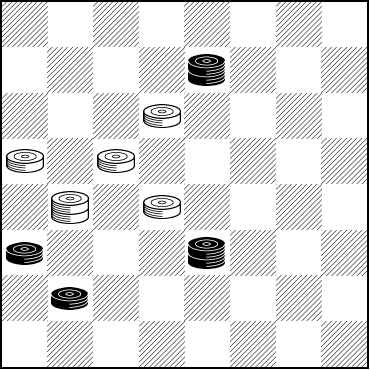
BLACK
Black to Play and Draw
B:B8,12,K10,K26:W15,19,20,23,K16
The thing was, Tommy had gotten nervous. His next move would make or break his bid for first team, and he knew it. Furthermore, his clock was running down and he had to make a decision quickly.
Finally, Tommy made his move.
This is not a difficult problem at all, and well within the reach of a player of Tommy's caliber. Can you match wits with Tommy--- and Duwayne? You likely don't have a promotion at stake, so enjoy the problem and then click on Read More to see the rest of the story, the solution, and many examples of this theme.![]()
We Got Problems

In regular life, problems are, well, a problem, and we don't want too many of them. But in the game of checkers, it's another story altogether.
In our ongoing Checker School series we've often stressed the importance of solving checker problems. But you don't need to just take our word for it. The following interesting passage appears in Andrew J. Banks' eclectic book, Checker Board Strategy. The author is Willie Gardner, a reknowned player and analyst from days past, and was first seen in the publication North American Checker Board.
Problem Solving
Problem solving is, in my opinion, the real science of draughts playing. In the study of problems one finds the greatest pleasure that the game affords, and at the same time insensibly imbibes all the requisites, analytical and constructive, that make the draughts player.
The study of the openings takes a second place in the education of the student. It is beneficial to the extent that the student may learn in an hour, from a compiled analysis of any opening, such traps and snares to avoid as would take him months, or probably years, to find unaided. However, in what position is the student who has crammed his head full of Sturges', Bowen's and Janvier's compilations, but has neglected the endings, when he finds himself with the winning side of First, Second, Third and other positions of the sort, and unable to effect the win? Such a player is celebrated for his great knowledge of the book; he is on a high pinnacle of fame, and the fall in his case is tremendous, sometimes greater than he can recover from. To play draughts well, and to find real pleasure in the game, I advise problems.
Sturges' collection is, perhaps, the best to begin with, and Gould's Book of Problems. Those with about four pieces on a side are my own especial favorites---long winded affairs, evolving the science of end-play. The two-to-two catch problems, though often brilliant, very rarely occur in play, hence their educational value is not so great. As to the crammer, what pleasure has he, with his mighty and extensive knowledge of every possible variation, when playing a game? He is simply automatic, if his opponent play so and so he knows the book reply, and there he sits, waiting for the other fellow to fall into some cut and dried loss, when he emits a mirthless chuckle, and remarks, so and so shows that to be a loss.
If the other fellow, however, gets off the beaten path, and wins, then Mr. Bookman cries, "I never saw that before! Where can I get some play on it?" Problem work is required throughout the game of draughts; its aid is required to win, and by its aid many an apparently hopeless game can be saved. Often I have heard the remark anent an old noted problemist, one of England's finest players in his day, that he never knew when he was beaten.
The end game student evolves from his every day practice his own natural systems of opening; this is the system that, I believe, brought forth the three greatest players the world has yet seen---Anderson, Wyllie, and Martins.
Willie Gardner
Interesting advice, and in accord with Grandmaster Alex Moiseyev's advice, "No opening books for the first thousand games!"
So let's solve a problem taken from Mr. Banks' book (he did not list the composer). This one is extremely easy.
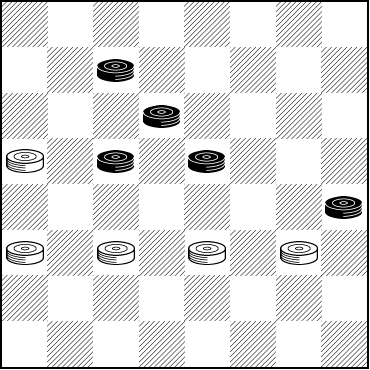
WHITE
White to Play and Win
W:B6,10,14,15,20:W13,21,22,23,24
How about one that's a little bit harder? This is from the same book and is attributed to Willie Ryan.
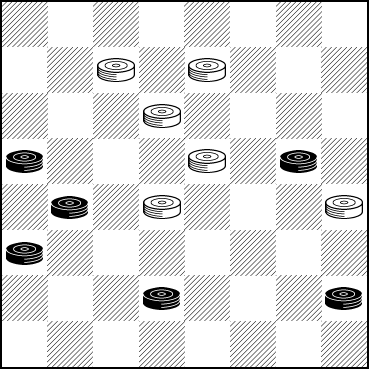
BLACK
Black to Play and Win
B:B5,7,12,16,17,20:W13,15,18,23,26,27
The problems are clearly at the beginner level, but as usual we invite more advanced players to see if they can solve them at a glance. Players of any level will of course have "no problem" clicking on Read More to see the solutions.![]()
Basic Checkers Part 8
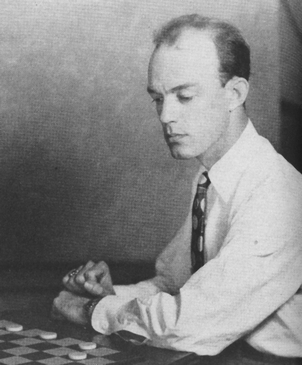
Richard L. Fortman (unknown date)
The late and legendary checkerist Richard Fortman in the 1970s assembled a set of typed manuscripts, in seven volumes, or parts, each one covering a family of opening moves. He called this collection Basic Checkers. It dealt with the first 20 moves in all of the then-current 3-move ballots. The book is filled not only with analysis and commentary, but also with anecdotes, stories, and much checker lore. It is to this day viewed as a classic and a must-study book for the aspiring master. The work was later revived in a modern one-volume edition, Basic Checkers 2010.

Jim Loy
Noted author and analyst Jim Loy has extended Mr. Fortman's work with Basic Checkers: Part 8, providing play corrections, alternative lines, and additional commentary. Mr. Loy used modern computer tools not available to Mr. Fortman, as well as his own considerable analytical skills. Part 8 was written with Mr. Fortman's original edition in mind but it is equally usable with the 2010 reissue.
Mr. Loy has generously provided us with Part 8 for free electronic distribution to the checker playing public. You can download Part 8 here or via the Jim Loy page linked in the right-hand column.

So, where can you get Basic Checkers?
Basic Checkers 2010 isn't available online but can be purchased from Amazon in the US and elsewhere for a reasonable price. Alternatively, in Part 8 Mr. Loy references an on-line version of the original Basic Checkers. That particular link has gone off the air but you can as of this writing still obtain the on-line version via the link below.
https://web.archive.org/web/20100507134443/http://home.clara.net/davey/basic.htm.
As a sample, here's a position that can arise from the 9-13 23-18 12-16 ballot. (For the run-up and full commentary, see p. 10 of Part 8.) Once thought to be a White win, it turns out Black can draw. Can you work it out?
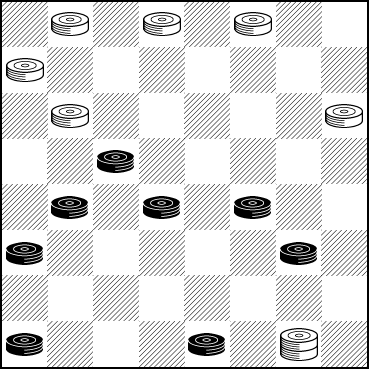
BLACK
Black to Play and Draw
B:WK1,21,24,28,30,31,32:B2,4,9,12,14,15,16,19
Yes, it's rather a challenge, but a fascinating one. Give it your best and then click on Read More to see the solution.![]()
Transpositions

There are transpositions in music; music in one key is transposed into another. It's something that's familiar to all music students.
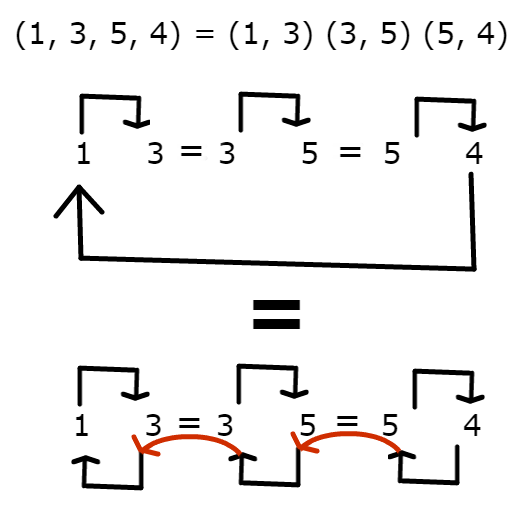
There are also transpositions in mathematics; the one shown above is from the branch of study known as group theory. We won't try to explain it here as it's more than a bit out of scope for a checker column.
What is in scope of course, is a transposition in a checker game. Transpositions are common in the openings, when one opening line, whether through a different order of moves or other means, transposes, or changes, into another opening line. (The concept can of course be generalized beyond openings.)
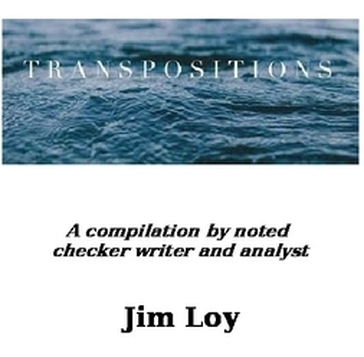
Jim Loy has put together a comprehensive booklet of opening transitions, and has generously offered it for free publication on our Checker Maven website. You can download the book here.
As an example, and today's problem, here's a landing known as the Pioneer, which can be reached by transposition from six different ballots.
BLACK
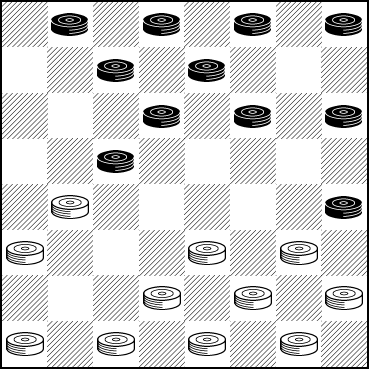
WHITE
White to Play
W:W17,21,23,24,26,27,28,29,30,31,32:B1,2,3,4,6,7,10,11,12,14,20
White now plays 29-25. If Black follows with 4-8, he falls into a losing position known as Dunne's Loss, as shown below.
BLACK
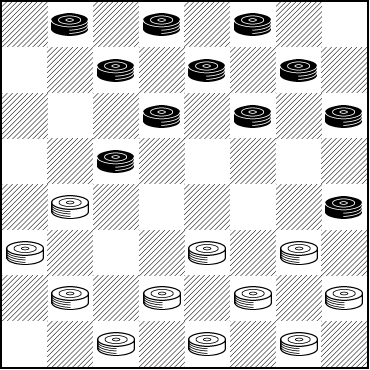
WHITE
White to Play and Win
W:W17,21,23,24,25,26,27,28,30,31,32:B1,2,3,6,7,8,10,11,12,14,20
What should Black have played instead?
Your task is to correct the losing move (not so hard) and to work out the White win, rather an advanced challenge, but instructive nonetheless. So see how well you can do, then click on Read More to see the winning play.![]()
Uncle Ben's Porch: Second Team

Tommy Wagner
Tommy Wagner had made Varsity on his high school team in central Florida. Except it wasn't quite as simple as all that.
In our last story, Tommy, as a freshman, was ready for spring tryouts. He had an outstanding record as Captain of the Junior Varsity team, and he did well in the tryouts and also during training month in August. Coach Schann had named him to the Varsity team in view of his progress.

Coach Schann
But that was the Varsity second team. The first team consisted of a titled Master and four Experts, and Tommy, though now at the very top of Class A, fell somewhat short. Tommy ended up on third board on the second team, and it meant he wasn't a starter and would only fill in as a substitute for first team.
Of course, he played in the second team matches, and got to play a couple of times as a first team sub during the fall, but as Christmas vacation rolled around, he was feeling a bit down. Second team matches didn't get anything like the attention that the first team got. No playing in front of big cheering crowds. No being something of a local hero in the high school halls.

It was Saturday morning, and Tommy had arrived a few minutes ago at Uncle Ben's place. Now, Ben wasn't really Tommy's uncle but everyone called him Uncle Ben. In fact he was a former professional checker player, who had some years ago wrapped up a great career and retired to Florida. He now did a little tutoring of promising young players.
Tommy went for a lesson at Uncle Ben's nearly every Saturday. They would sit out on Uncle Ben's front porch, usually with a pitcher of Uncle Ben's wonderful homemade lemonade, and study checkers for a couple of hours. Uncle Ben was a great coach, and often taught Tommy lessons that went beyond checkers and into coaching for living.
Today Uncle Ben could see that Tommy was despondent, and rather than starting out with a checker problem for Tommy to solve, Uncle Ben poured out the lemonade and decided to just chat for a little while.

"So what is it, Tommy? What's on your mind? You've made Varsity, that's a big accomplishment for a young player. Not everyone makes it at the start of sophomore year."
"I know, Uncle Ben," Tommy replied, "but it's third board on second team, and I only got to play twice in league competition, as a last minute substitute on fifth board when coach decided to give me a little experience. I want to be on the first team and play all the matches."
"Well, Tommy, it seems like we've had similar discussions before, about earning things and being patient."
"I know, Uncle Ben, the first team players are all better than I am. I get it, I really do, but I just want to play. When I was on Junior Varsity, at least I got in a lot of time on the board."

"So, what do you think it will take for you to move up to first team? What do suppose Coach Schann is looking for?"
"For me to improve? I mean, that has to be it, I have to get better, I guess, good enough to compete with those Experts and Masters on first team."
"Exactly, Tommy. Your coach will move you up when you're ready, no sooner and no later. Things don't come to us just because we wish for them. They come because we work for them. Do you know, when I first made it to the Major Leagues, when the Houston Huffers called me up, I sat on the bench for quite some while? I'd get to play every so often but the top players got the glory. I was a sub, just like you are. It wasn't easy, but I kept practicing and working, even though I had already made the Big Show. Then, one day, I got my chance, and I never looked back."
"Gee Uncle Ben, you think I can do that too?"
"Of course you can, Tommy. You worked your way up to Captain of Junior Varsity and then you earned yourself a spot on Varsity, even if it isn't as a first team starter. So you've got what it takes, and I suspect that by the latter part of the season you'll be playing more often. But only if you keep up your studies--- and maintain a positive, can-do attitude."

"Well, I'm ready to do what it takes, Uncle Ben."
"Very good. So let's work extra hard today. Here's a problem for you to study, and we'll do several more when you get this one. It might turn out to be a long morning, but we've got lots of lemonade."
Uncle Ben set up the following position and Tommy, who at times needed a reminder that patient hard work precedes success, dug right in.
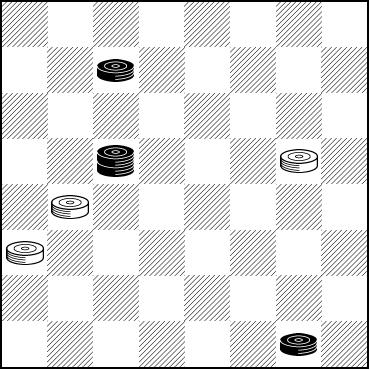
BLACK
BLACK to Play and Win
B:B1,27,K19:W12,16,17
If we don't miss our guess, you, our reader, aren't a second team Varsity player at a local high school, although one never knows. But you're here because you're a checker fan, and you've likely long ago learned that mastery of checkers doesn't come overnight. Can you solve Uncle Ben's problem? See if you can, and then click on Read More to see the solution, notes, and numerous additional examples of the theme.![]()
Scott's Close Shave

Cutting your lawn very short, perhaps too short for the good of the lawn, is often referred to by a term which is now considered politically incorrect and offensive to some. The word in question supposedly shouldn't be used any longer.
But an alert reader pointed out that, in our republication of Willie Ryan's Tricks Traps & Shots of the Checkerboard, we omitted an entry called Scott's Sc*lp*r. We're remedying that omission with today's column and have renamed it Scott's Close Shave, which we hope will make the LTBO ("Looking To Be Offended") crowd happy.
Let's let Willie give an introduction in his own words.
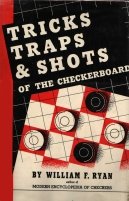
"The feature performers in this draughts drama were Robert Jackson and A. B. Scott, two of England's foremost players at the turn of the century. Sir Scott, who handled the white pieces, was a sagacious specialist in the management of weak, off-color, or radical moves, which in most cases he had carefully analyzed and prepared in advance. It is evident from Champion Scott's fine play in the game below, that he was thoroughly familiar with all aspects of the formation into which he lured his opponent, enabling him to spring the hair-raising finale at the diagrammed stage."
Willie's analysis of this game is uncharacteristically flawed. The KingsRow computer engine uncovered some very interesting play. Here's the complete run-up, with notes.
| 1. | 11-16 | 24-20 |
| 2. | 16-19 | 23-16 |
| 3. | 12-19 | 22-18 |
| 4. | 8-11 | 27-23 |
| 5. | 11-16 | 20-11 |
| 6. | 7-16 | 25-22 |
| 7. | 4-8 | 29-25 |
| 8. | 8-11 | 31-27---A |
| 9. | 10-15 | 21-17---1 |
| 10. | 9-13 | 27-24 |
| 11. | 5-9---2 | 25-21 |
| 12. | 1-5 | 32-27 |
| 13. | 2-7---B,3 | 30-25 |
| 14. | 3-8 | 18-14* |
| 15. | 9-18 | 23-14 |
| 16. | 6-10---4 | Forms diagram. |
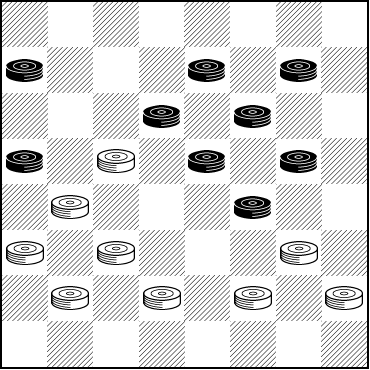
WHITE
White to Play and Win
W:W14,17,21,22,24,25,26,27,28:B5,7,8,10,11,13,15,16,19
Lettered notes are by Willie Ryan. Numbered notes are by your editor.
A---A powerful attacking move developed by Robertson, Martins, and Wyllie.
B---With this move, Jackson passed up his last chance to draw, but who would ever believe that his choice was to be invalidated in the manner shown? The correct continuation at B is: 6-10, 17-14, 10-17, 21-14, 13-17---5, 22-6, 15-31, 24-8, 31-24, 28-12, 2-27, yielding a draw. John Robertson.
1---Willie didn't note this, but the move appears to lose according to KingsRow.
2---2-7 would have kept a stronger advantage but Black may still have a win.
3---Turns a probable win into a possible loss. Willie's analysis isn't quite correct. See note B above.
4---A mistake that loses at once. 6-9 would have given Black better chances although he's still in a possible loss.
5---This move is hard to understand and throws away the win. 3-7 is correct here. Perhaps the spectacular exchanges diverted Willie's attention.
Do you see the White win from the diagrammed position? Work it out and then click on Read More to check your the solution.![]()
Complete Checkers: Repertoire
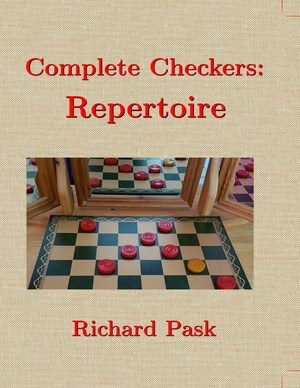
It's here! Grandmaster Richard Pask's long-awaited Complete Checkers: Repertoire is available in a free electronic edition and an inexpensive print volume. The content has been developed, refined, tested and verified by Mr. Pask over a period spanning some forty years. A year in production, the book is at last ready for general release.
CC:R, as we also call it, is the master-level companion volume to Complete Checkers: Insights, published just about a year ago. Together the two books take the aspiring and ambitious player, willing to put in the necessary time and practice, from utter novice to accomplished master. And even if you are not looking to become the next champion, the books provide nearly endless checker entertainment and education, and are bound to raise your level of play and enjoyment.
The new book checks in at 478 large-size double column pages. It's a rewrite and expansion of Complete Checkers: 3rd Edition and contains thousands of additions and improvements.
You can get your free electronic copy here or from the Richard Pask page linked in the column to the right. The print book can be obtained from Amazon in the US or from its other worldwide outlets. We hope that, if you find the book useful and it's within your means, you'll support the project by buying a print copy, which is priced only at a level to eventually recoup our direct costs.
We thank Mr. Pask for his generosity in providing this capstone work without charge to the checker playing public, and for his trust in us by allowing us to edit and publish his incredible books.
Here, as a bit of a teaser, is something from the book. It's from the 10-15 22-17 9-13 ballot, arising from a game played between D. Zevenia and R. Cornell in 1964.
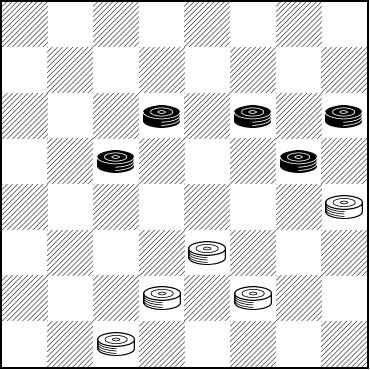
WHITE
White to Play and Win
W:W20,23,26,27,30:B10,11,12,14,16
This isn't all that difficult--- if you can see it, that is. It's positively amazing. Give it a try and then click on Read More to see the solution and run-up. And definitely get hold of Mr. Pask's new book!![]()
A Good Coach

Our Checker School series has featured several problems and excerpts from Andrew J. Banks' quirky but fascinating book Checker Board Strategy, published back in 1945. Mr. Banks came up with a set of characters, such as Farmer Sneed and Skittle, whom he utilized in short sketches to illustrate various principles related to learning the game of checkers.
Here's a short sketch Mr. Banks entitled A Good Coach.
A Good Coach
Said Aristotle, "The one exclusive sign of a thorough knowledge is the power of teaching." The popular Internationalist, has this power. He usually preferred to demonstrate problems, rather than games. In studying a game is not the student tempted to merely guess at the reasons for the moves? However, in solving a problem, he must think accurately. The Internationalist, without using a board, often solved all the problems in an issue of Wood's Checker Player. With amazing speed, he solved gems that players set up for him; he has mastered over 25,000 problems. Moreover, his teaching ability equaled his great skill.
His method was to tactfully indicate where and why Skittle had failed to solve a problem. Skittle's second attempt consequently was superior to the first; whereupon the Internationalist warmly congratulated him; and this made Skittle energetically try to solve more problems. Encouragement does not make a pupil wiser, but it does enable him to endure correction. Said Mr. Johnson, "The applause of a single human being is of great consequence."
What Skittle learned served him well; he felt that his play was his own---not his teacher's. He received excellent advice and theories, but no set rules. There are no formulas in checker playing---each player must develop his own style. He should remember that study and copy are two different things.
Skittle developed the feel of the game, an observing eye, and new exciting ideas. How did he learn so rapidly? He made mistakes, corrected them; made more, corrected THEM; and repeated this process over and over. Great things are performed not by strength but by perseverence.
In the story, Mr. Banks refers to the "Internationalist." There are several players who were called that. We're not sure who he means. We think it might be Harry Moulding, but we don't know for sure. Can any of our readers shed some light on this?
In any event, here's the problem Mr. Banks provided to go with his little tale.
WHITE
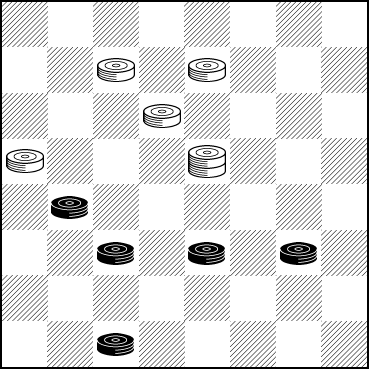
BLACK
Black to Play and Win
B:WK18,20,23,26,27:B3,9,10,11,16
Depending on your skill level, you might need a little coaching on this one. It's quite clever and pleasing. See how you do and then coach your mouse over to Read More to see the solution.![]()
Theory of Fun
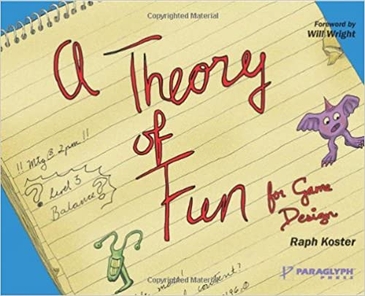
There's an interesting book titled A Theory of Fun for Game Design by Raph Koster, published in 2004. The book touches on some valid points about how games are designed and ultimately played. However, when it comes to our game of checkers, Mr. Koster says the following.
"Until now, I've been discussing formal game design--- abstract simulations. But we reely see truly abstract simulations in games. People tend to dress up game systems with some fiction. Designers put artwork on them that is suggestive of some real-world context. Take checkers for example--- abstractly it's a board game about entrapment and forced action, played on a diamond-shaped grid. When we say "king me" in checkers, we're adding a subtle bit of fiction to the game; suddenly it has acquired feudal overtones and a medieval context. Usually, the pieces have a crown embossed on them."
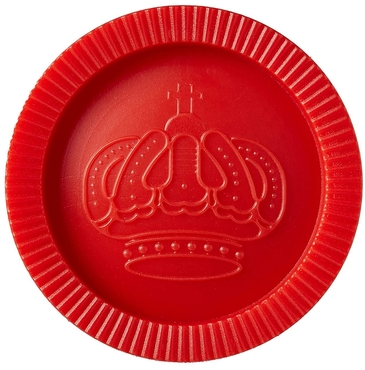
We don't have enough space in this column to discuss all of Mr. Koster's errors and misconceptions; suffice it to say that he seems to have little or no knowledge of checkers played as a serious game. However, we did get genuine amusement from the idea of "feudal overtones" related to the process of crowning a piece. We wonder if, as a potential player, he would also subscribe to the common erroneous advice to "always keep your king-row intact."
So, for today's checker problem, let's use our collective imagination. Think of the kings as bearing jeweled crowns and dressed in the finest of purple robes. Think of the men as clad in leather armor and metal helmets, bearing swords, axes, and pikes. Think of the checkerboard as the field of battle, perhaps in ancient Carthage (ancient rather than medieval, but still quite colorful). Listen to the call of trumpets, the beat of drums, the battle cries of the massed warriors.
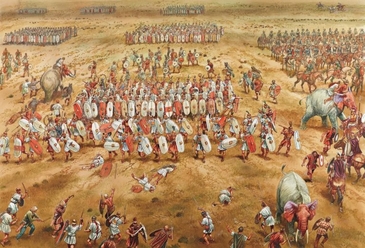
Or maybe not. Perhaps you'd just like to solve a good checker problem without a lot of distracting imagery. It's up to you. Was Mr. Koster correct or incorrect with his medieval contexts and feudal overtones? Does it really matter?
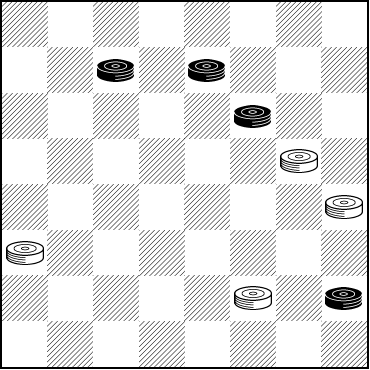
WHITE
White to Play and Draw
W:W16,20,21,27:B6,7,11,28
See how you do with this one and then click on (or march over to, if you will) Read More to view the solution.![]()
Draughts Down Under

Australians Bob and Norma Meadley come from the very small town of Narromine in New South Wales, where Bob pursues his hobby of draughts (checkers) and Norma volunteers at the local library. "Narromine" doesn't refer to a "narrow mine," as you might think, but instead is derived from a word in a native Australian language which means "honey people."

The Meadleys have sent us a most unusual book, you might say a honey of a book, with permission to distribute it gratis to the checker community. It's a book they've worked on for quite a long while, pulling together a rambling, eclectic combination of materials ranging from articles on the history of checkers (draughts) to rare newspaper clippings and photos and documentation of James "The Herd Laddie" Wyllie's visit to Australia and New Zealand.

Bob Meadley
Mr. Meadley sent me the following fascinating notes about the book's cover (shown above):
"Now a little bit of history about that old board. When I was in my mid 20s I went over to the grand old man of Australian Chess Problems and he was only 3 years away from dying in 1968. He gave me the board which consists of timber strips held together by canvas cloth. It dates to the late 19th century from when he was a young man (born 1880) and played chess in rural NSW. The patina is untouched but I did have to reglue some new canvas on one rotted part. The three boxes of draughts men (left; all black and white) are 'Dreadnaught Products'; 'The National Games Draught Men' (right); an unnamed set on a fine board just called 'Draughts'(middle); and finally 'Marquis Plastic Moulded Draughtsmen' (2nd row left). The scattered red and black men are mine from my teenage years where we played in the railway workshops."
The book is lovingly assembled and runs to more than 300 pages. It will provide hours of checker entertainment and amazing insights and information. You can get it here.
Of course no Checker Maven column is complete without a checker problem, and so we've selected this one from the book.
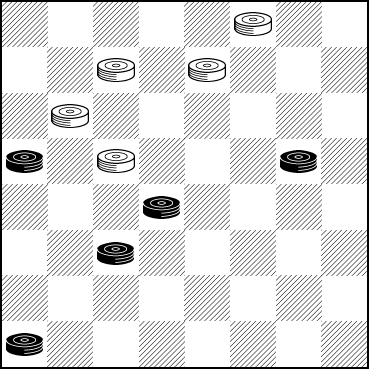
BLACK
Black to Play and Draw
B:W19,24,26,27,30:B4,11,15,17,20
You'll find this on page 143 of the book, but alas, without solution. Is this a "honey" of a problem? See what you think by trying to solve it, but it's a sweet thing to realize that clicking on Read More will show you the winning way.![]()
The Checker Maven is produced at editorial offices in Honolulu, Hawai`i, as a completely non-commercial public service from which no profit is obtained or sought. Original material is Copyright © 2004-2024 Avi Gobbler Publishing. Other material is the property of the respective owners. Information presented on this site is offered as-is, at no cost, and bears no express or implied warranty as to accuracy or usability. You agree that you use such information entirely at your own risk. No liabilities of any kind under any legal theory whatsoever are accepted. The Checker Maven is dedicated to the memory of Mr. Bob Newell, Sr.

